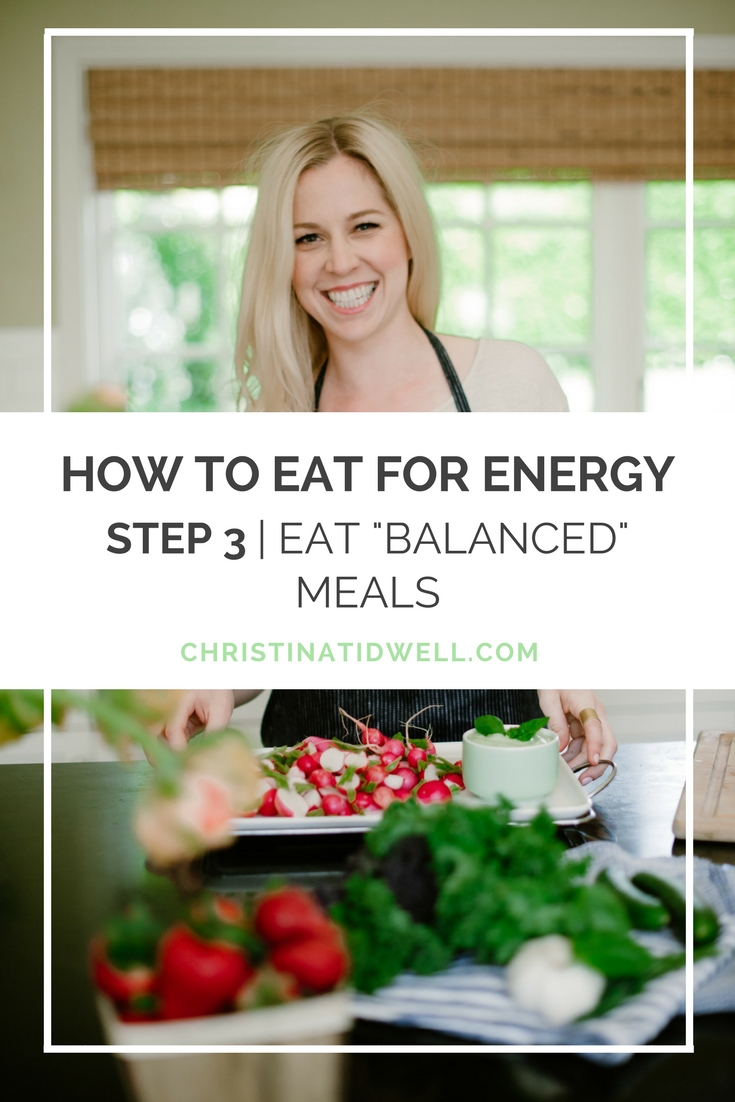How to Eat for Energy - Step 3: Eat Balanced Meals
Today we're on to step three in the five steps of eating for energy and getting rid of that 3 PM "crash."
Last week we talked about exactly which types of foods you’ll want to prioritize in order to balance blood sugar and to avoid the blood sugar roller coaster. If you missed Step 1 and Step 2, join in and read about them here:
STEP 1: Balancing Your Blood Sugar >>
STEP 2: Eat real, whole foods >>
In Step 3, I want to focus on the composition of your meals and what it really means to eat a “balanced” meal. This has been the most important step for me personally in learning how to eat for fuel and energy, and I’m excited to share it with you!
Watch my video below or read on to find out how to compose your meals so you feel full, satisfied and full of energy!
So let's talk about eating balanced meals. This is probably the biggest game changer for me in terms of eating for energy and something that I consider with every single one of my meals and snacks.
Have you ever brought a nice, nutritious salad for lunch that's just full of vegetables, and then an hour later you find yourself completely starving and not satisfied? You might find yourself thinking, "Okay, I just can't cut this healthy eating thing, it's not for me!" I used to do this when I was in college. I'd try and eat healthy where I'd just eat a salad from the salad bar that really just consisted of vegetables, and I'd have an orange on the side and I wondered why eating "healthy" felt like such a test of willpower all the time.
It's not that those weren't good choices. It's really just that I wasn't eating balanced meals that were allowing me to feel full and satisfied for longer periods of time.
When we think about balance or eating balanced meals, we often think about balancing calories in versus calories out. We might think about eating a balanced meal that's dictated by the old school food pyramid that tells us that a healthy balanced diet is going to consist of six to twelve servings of grains (refined or whole grains) and always a big glass of nonfat milk on the side.
So what comes up when you think about balance? Is it the food pyramid? Is it calorie counting?
What I want to focused on today is considering balance not in relation to balancing calories in versus calories out, or on the quantity of food, but really the quality of the food that we put in our bodies which matters the most.
To be balanced, each meal and even snacks should have a balance of the following four components:
Protein
Fat
Carbohydrates
Fiber
Below is a list of some ideas of what to eat in each category. This list is definitely not exhaustive and will be dependent on where you're at with your specific dietary needs but it's a starting point. The idea is to pick one item from each list when composing a meal or snack.
Protein:
Beef (ground, whole meat, deli style slices, sausages, jerky/sticks, etc.)
Chicken (ground, whole meat, deli style slices, sausage, etc.)
Turkey (ground, whole meat. sausage, jerky/sticks, deli style slices)
Coconut yogurt (unsweetened)
Eggs (if tolerated)
Fish (Anchovies, bass, cod, flounder, tilapia, halibut, Mahi Mahi, salmon, sardines, Lake trout, tuna)
Shellfish (crab, clams, lobster, mussels, scallops, shrimp, squid/calamari)
Lamb
Fat:
Oils (Avocado, coconut, extra virgin olive)
Olives
Avocado
Coconut milk, flakes, fresh “meat”
Hummus, tahini, nut butters
Fiber (from veggies!)
Artichoke hearts and leaves
Asparagus
Beans (green, wax, Italian)
Brussels sprouts
Broccoli
Cabbage (green, bok choy)
Cauliflower
Celery
Cucumber
Daikon radish
Greens (collard, kale, mustard, turnip greens, spinach, chard)
Jicama
Leeks
Mushrooms
Onions
Radishes
Salad greens (chicory, endive, escarole, lettuce, romaine, spinach, arugula, radicchio, watercress)
Summer squash
Sugar snap peas
Swiss chard
Turnips
Zucchini
Carbohydrates (starchy veggies)
Carrot
Sweet potatoes
Beets
Rutabaga
Plantain
Pumpkin
Squash
Rice or quinoa (if you can tolerate gluten-free grains)
Every time I have a plate, I'm looking at it to see if I'm missing one of these four things. You'll be amazed at how just considering this one rule is going to do a lot of great things for your overall energy level and your feelings of fullness and satisfaction after meals!
I even consider balance with my snacks. For example, if you're grabbing an apple or a banana, make sure you put some almond butter with it, so you have slower burning fats alongside the fiber and the carbs to get a more even energy burn.
Here are two examples of balanced meals with the different components identified. Let me know what ingredients you use to create balanced meals!
In Step 4 we're going to explore caffeine and it’s effects on fatigue, which is a topic that I get a lot of questions about. Don't worry you don't have to give up your coffee just yet, there's just a few things to consider to help you feel less drained and more energized :) Stay tuned!
GET MY SIMPLE BATCH COOKING MEAL PLAN FOR FREE!
YOU’LL GET:
+ 7 day meal plan
+ Step by step instructions for how to cook an entire week’s worth of food in just two 2-hour sessions (life changing!)
+ Grocery lists
+ Twelve of my favorite, easy recipes
Enjoy making delicious and nutritious meals in way less time!




